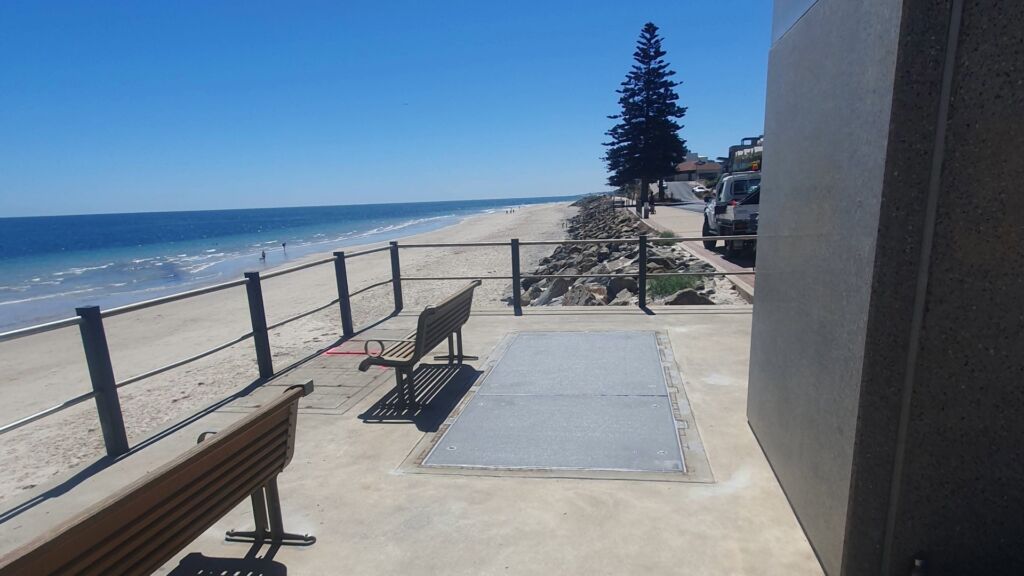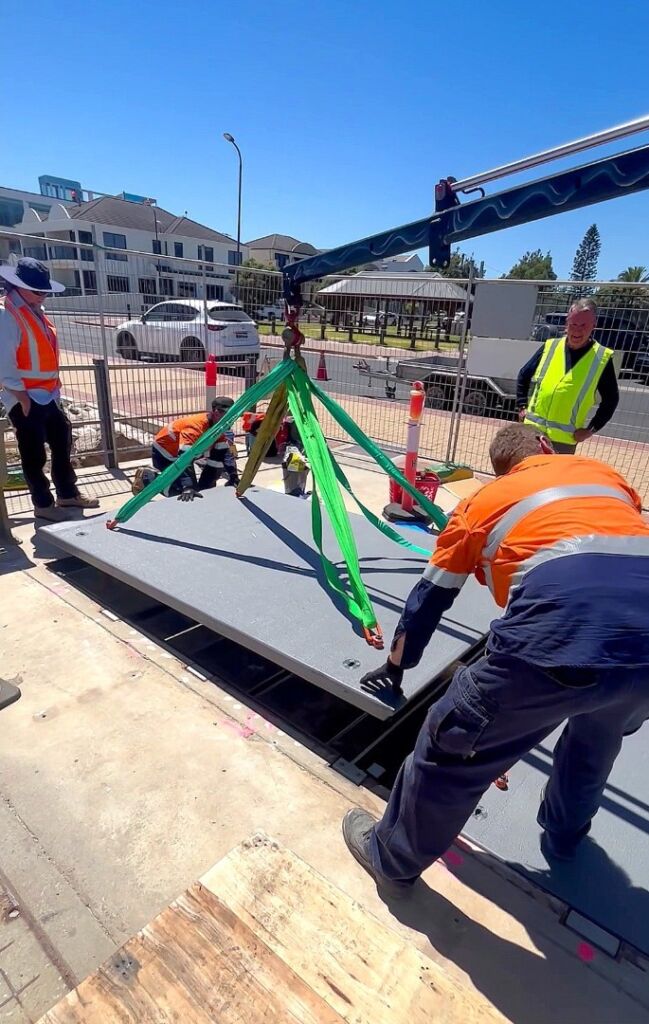Australia’s coastlines are among our most valuable natural assets. To keep them healthy, many councils rely on sand pumping stations to redistribute sand from areas of buildup to those affected by erosion. These systems help maintain beaches, safeguard property, and support tourism, but they operate in some of the harshest environmental conditions.
The mix of saltwater exposure, constant moisture, and abrasive sand creates a demanding environment for the pit lids, access covers, pumps, and electrical assets that keep the stations running.
To solve these challenges, Fibreglass Reinforced Polymer (FRP) has emerged as a durable and safe solution. But before looking at how FRP addresses these issues, it’s important to understand the challenges traditional materials face in coastal infrastructure.
The burden of maintenance for sand pumping stations
Traditional concrete and cast iron heavy duty pit lids have long been used in coastal applications, but they have a few shortcomings that innovative solutions like FRP can address. Common issues include:
- Corrosion: Cast iron pit covers are prone to corrosion and seizure caused by salt spray and humidity. This results in additional maintenance time to free stuck panels.
- Easily damaged: Concrete lids often crack or break when heavy machinery or vehicles pass over them, and exposure to salt and sand accelerates wear in coastal environments.
- Heavy and hazardous: Traditional multi-part heavy duty pit lids and pit covers often require mechanical lifting equipment, adding complexity and safety risks to routine maintenance. There’s also a high risk of manual handling due to awkward postures that lead to an increased risk of strains and hand injuries.
- Slow access time: Heavier, multi-part covers require multiple lifts and frequent realignment, slowing down maintenance cycles.
- High maintenance costs: Each repair or replacement is labour-intensive, hazardous, and requires specialised machinery, especially problematic across widespread coastal sites.
Over time, these issues compromise both safety and asset lifespan, driving up maintenance demands. For coastal authorities managing pump stations across long stretches of shoreline, even minor pit cover damage can escalate into disruptive repairs and added risk.
The shift to smarter, safer access systems
In recent years, coastal councils have increasingly adopted composite access covers recognising their advantages over traditional materials. Infrastructure teams now have access to a smarter alternative engineered to withstand saltwater, sand abrasion, and heavy operational use.
Terra Firma’s engineered FRP pit lids and access covers offer:
- Lightweight design: Composite pit lids and access covers reduce reliance on heavy lifting gear, making inspections safer and faster for maintenance crews. It’s also designed with integrated certified lifting points for a Ute mounting crane.
- Lower whole-of-life costs: Long-lasting, corrosion-resistant materials reduce replacement frequency and maintenance spend.
- Full compliance: Engineered to meet Australian Standard AS3996:2019 and key council and regulatory requirements.
- Strong and durable: Our class B pit lid retains strength and shape even under impact and, unlike concrete, won’t crack or break apart. Plus, our bolts and hardware are specified for marine environments.
- Easy installation and retrofitting: Fit neatly into existing pits or new developments, reducing disruption and downtime.
- Customisation: Engineered to integrate with existing site infrastructure and machinery, our composite access covers simplify installation and avoid costly redesigns.
Designed specifically for demanding environments, Terra Firma pit lids are ideal for coastal pumping, marina, and waterfront applications, where traditional materials are hard to maintain and dangerous to handle.
Case Study: SA Sand Pumping Station

This approach is already in use at a South Australian Sand Pumping Station, where Terra Firma’s engineered FRP pit lids were selected to provide safe, corrosion-resistant access in a salt-rich, high-abrasion environment.
The team performs maintenance every quarter, but the original heavy duty pit lids were difficult to handle, broken in places, and offered no fall protection – creating serious safety and operational challenges.
To address this, Terra Firma delivered a custom solution with key features:
- The FRP lid system was designed as a multi-part custom solution, specifically to be removed with a truck mounted crane already in use by the SA team.
- The lids were custom-designed to match the client’s existing crane setup, meaning no special tools or new lifting systems were needed.
- The system retrofits into the existing infrastructure, reducing installation time and avoiding costly redesigns.
- Crews now complete open and close cycles up to 60% faster, thanks to fewer lift steps, non-rusting components, and controlled Hiab-assisted handling.

Early feedback points to easier maintenance access, improved safety, and strong confidence in long-term durability, demonstrating how engineered FRP systems can deliver reliable performance in demanding coastal environments.
Whole-of-life benefits of FRP for access covers
Beyond immediate safety and handling advantages, FRP delivers long-term performance benefits across an asset’s entire lifespan. With fewer lift steps, lower injury risk, and minimal maintenance, it delivers around 45% better lifecycle ROI than traditional systems, providing measurable gains in safety, efficiency, and cost over time.
- Longevity: FRP components typically last 30 years or more in corrosive or abrasive conditions – far longer than concrete or steel.
- Reduced maintenance: No repainting, corrosion treatment, or heavy lifting equipment required.
- Enhanced safety: The lightweight design makes routine access faster and safer for maintenance crews. It also eliminates high-risk manual handling and awkward postures, reducing the likelihood of pinch and crush injuries by an estimated 60-75%.
- Environmental resilience: Resistant to UV exposure, saltwater, and temperature changes, maintaining performance without degradation.
- Lifecycle efficiency: Lower transport and installation costs contribute to reduced embodied carbon and overall project value.
For councils and contractors alike, this means infrastructure that performs better, lasts longer, and costs less over time, while also improving safety outcomes for field teams.
Building coastal resilience that lasts
As coastal councils continue to invest in shoreline protection and beach nourishment, infrastructure materials must evolve alongside environmental demands. The combination of engineered FRP pit covers and smarter access design gives asset owners a sustainable path forward, safer for crews and more cost-effective maintenance across decades of service.
From stormwater and utilities to sand pumping and marine infrastructure, Terra Firma pit lids and access covers are helping Australia build coastal assets that last.
Discover how Terra Firma’s safe and smart FRP solutions are transforming coastal infrastructure across Australia – and see the results for yourself in our real-world case studies.
Share this
Discover the Terra
Firma difference
Learn how we can help support your next project